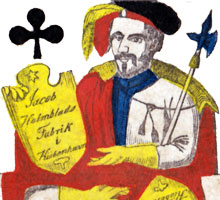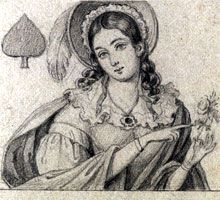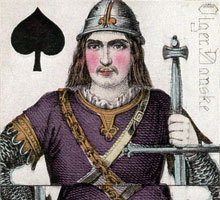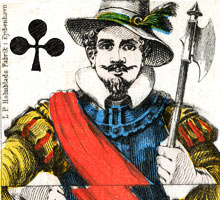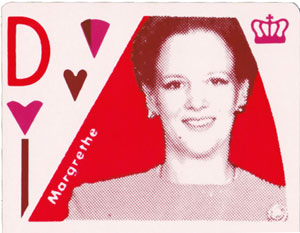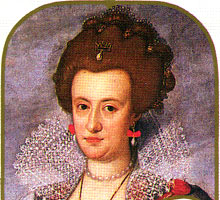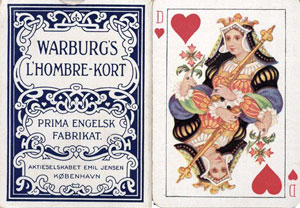History of Danish Playing Cards
The earliest mention of playing-cards in Denmark dates from 1487 when King Hans, who reigned from 1481-1513 and was notorious for his gambling, again and again drew money from the treasury to pay for his losses.
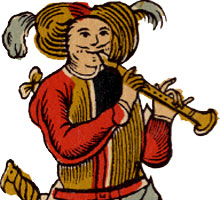
Playing Cards in Denmark
Spillekort i Danmark
The earliest mention of playing-cards in Denmark dates from 1487 when King Hans, who reigned from 1481-1513 and was notorious for his gambling, again and again drew money from the treasury to pay for his losses. Cards were mostly imported from France and Belgium, but the earliest Danish playing card production-monopoly was given in 1673 to Fridrich Jacobsen, therefore probably showing that local production commenced sometime around that time. However, a secondary source reports that Fridrich Jacobsen's cards were so bad that shopkeepers would not sell them! No examples have survived.
An early existing pack of cards known to be printed in Denmark is an Animal Tarok pack which follows Belgian designs, made by the printer Jean Friedrich Mayer, who had been granted a royal licence to print playing-cards from 1752-1783. Mayer also published standard 'Paris' type decks, in the traditional French style, with named court cards.
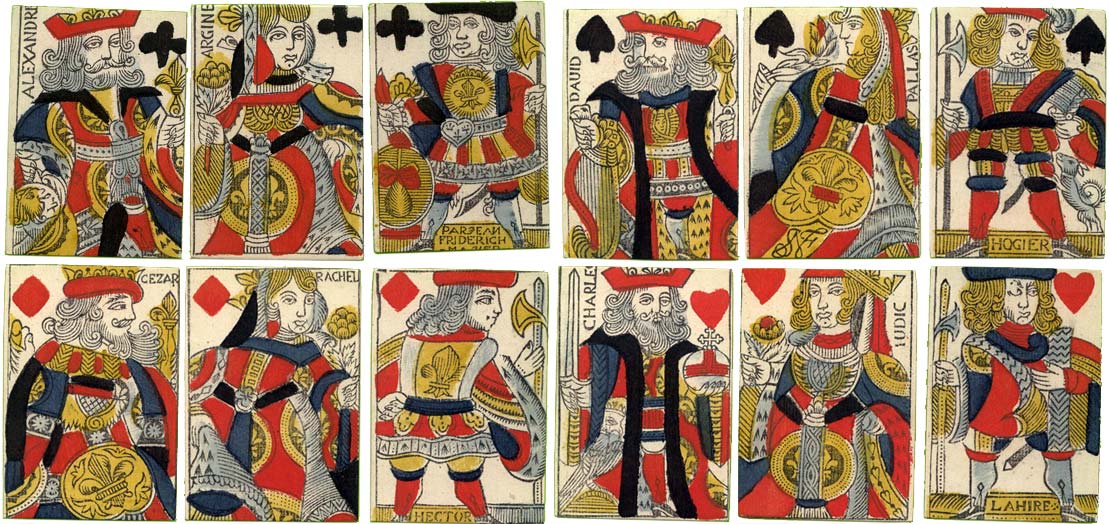
Above: standard 'Paris' type deck, in the traditional style, printed from woodblocks in black-and-white and then hand-coloured using stencils, with named court cards, produced in Denmark by Jean Friedrich Mayer, 1752. The cards have been cut too close for comfort; possibly they have been trimmed by a previous owner. Image courtesy Hans J. Hinrup.
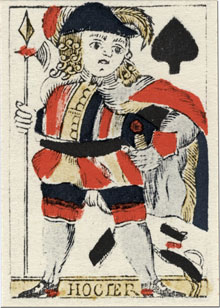
Mayer's licence was taken over in 1783 by Christoffer Ernst Süsz, who was joined in 1790 by Kunze, and who also produced Animal Tarok packs, as well as Paris-type packs with single-ended and named courts. Similar packs were produced by Pierre Steinmann (active 1798-1820)→
The game of Gnau consists of forty-two cards and is the Danish version of the old game of Cucu. • See: Keiblinger Gnav→
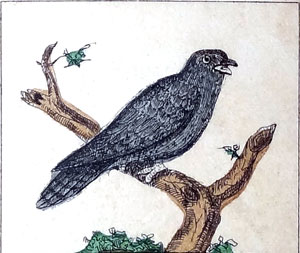
← Left: Jack of Spades by Christoffer Ernst Süsz.
He has a leaping dog and the name 'Hogier'
in accordance with French tradition.
• See also: C.L.Keiblinger, Copenhagen 1852-85.
The Holmblad Dynasty
The most celebrated Danish cardmakers belonged to the Holmblad family. Jacob Holmblad came from Sweden in about 1766. The production of playing-cards by the Holmblad family started with the granting of a royal licence in 1820 to Jacob Holmblad (1791-1837). To begin with he carried on the European influence already established by his predecessors and published continental-style decks and Animal Tarok decks following Belgian designs. But then he dropped the French names from the court cards and began introducing changes into the designs so that over time original and new patterns emerged with a distinctive Danish flavour.
After his death in 1837, playing-card production was continued by his son Lauritz Peter Holmblad (1815-1890) who rejuvenated some of his father's patterns and commissioned new designs incorporating ideas of his own. It was he who was the real founder and developer of the Holmblad patterns. The royal licence was formally transferred to him in 1841, and Holmblad became a household name which appears on Danish packs even today. In his diary in 1865 he wrote: “Various improvements were introduced into my production this year... such as a new printing machine, a stereotype press and a polishing machine...”
In around 1850 L. P. Holmblad parted from the tradition of Animal Tarock packs and published newly-designed packs depicting prominent buildings from in and around Copenhagen (click on images).
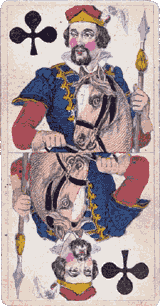
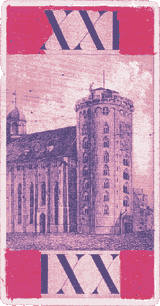
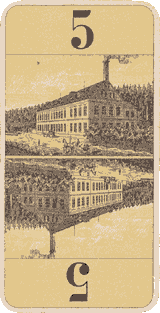
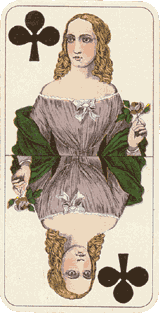
After L.P. Holmblad's death in 1892 the Copenhagen factory was closed. Holmblad's successor S. Salomon acquired the rights to use these playing-card designs and continued producing packs under the Holmblad name. Hereafter the Holmblad house patterns were printed as brand names by foreign makers such as Wüst of Germany, Piatnik of Austria, as well as Belgian manufacturers and even Waddingtons of England see more →
Adolph Wulff of Copenhagen published L'Hombre No.60, Luxuskarte No.75 and Whist No.80 manufactured in Germany in the late 1920s and early 1930s. Aktieselskabet Emil Jensen of København published several decks in the 1930s & 40s including packs made in England: “Luxus Bridgekort” specially designed by Barbara MacDonald and special packs to commemorate King Christian X of Denmark in 1935 and 1937. The principal cardmaker in Denmark today is Handa.
Conjuring cards
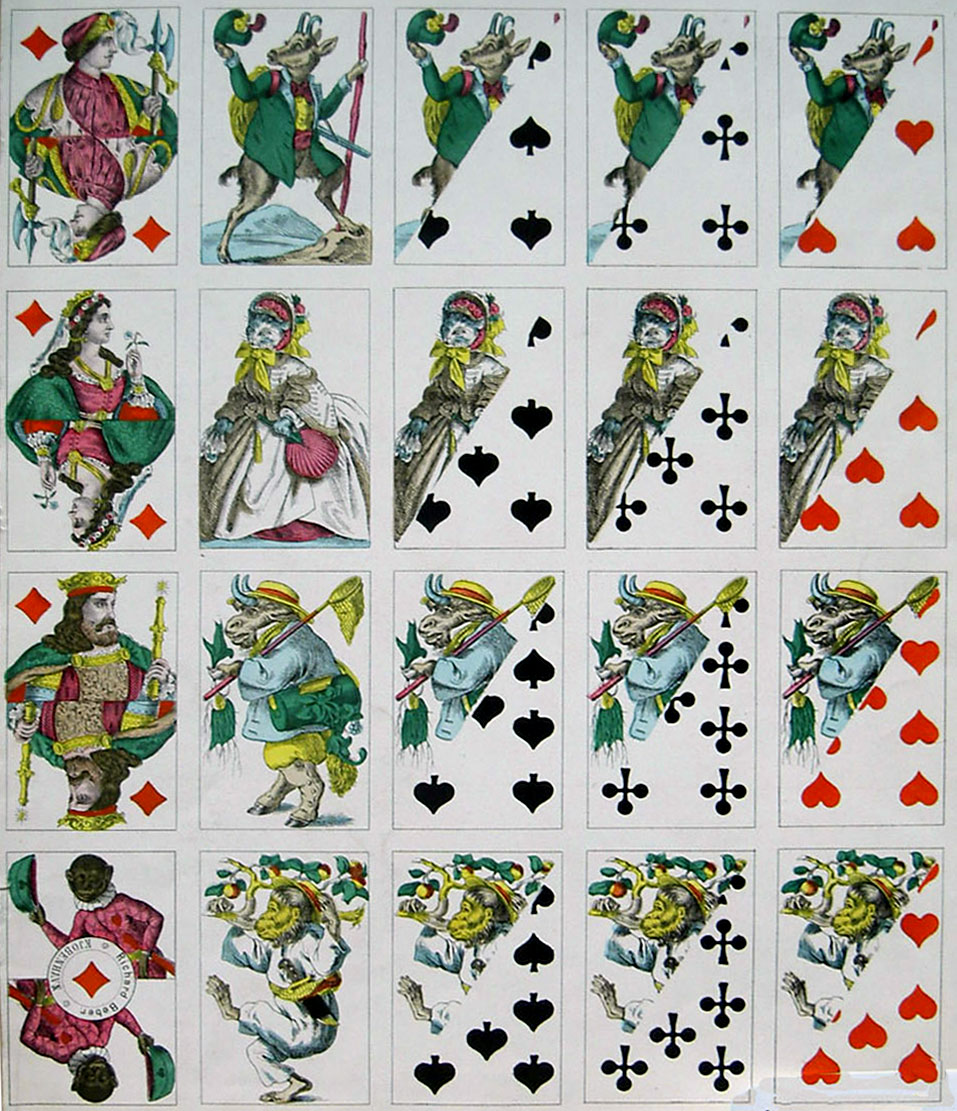
Above: special double-ended playing cards for conjuring with comical figures made by Richard Beber, Copenhagen late 19th century.
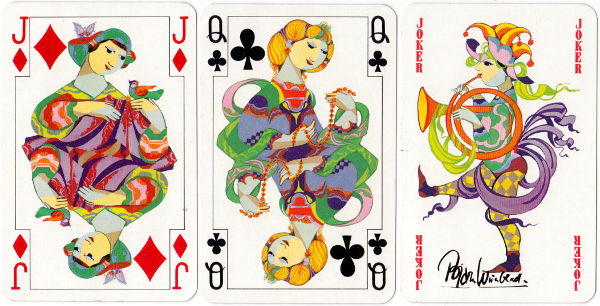
Above: Bjørn Wiinblad playing cards
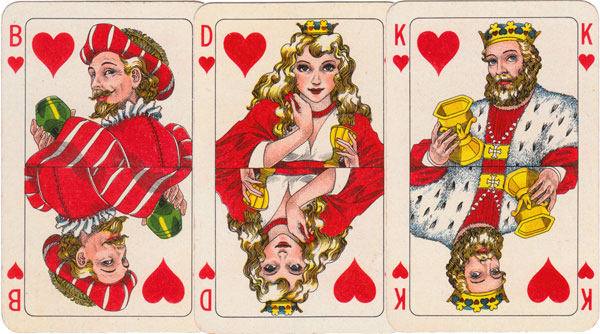
Above: Warburg’s Danske playing cards published by Aktieselskabet Emil Jensen, København, 1944
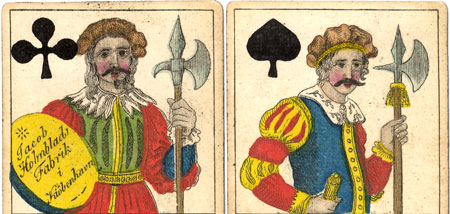
Above: two Jacks from an Animal Tarok deck by Jacob Holmblad, c.1830, following continental designs.
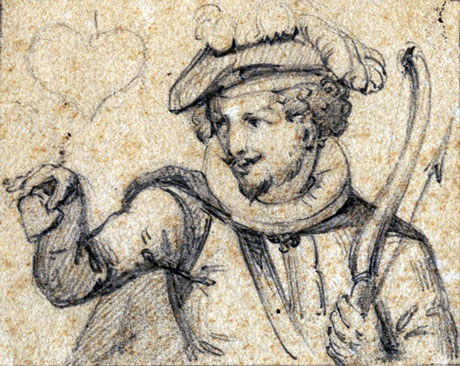
Above: original artwork for a completely new figure for the Jack of Hearts playing the part of Amor with a bow and arrow in his left hand and a heart dangling in his fingertips in his right hand, possibly inspired by Hans Christian Andersen. Image courtesy Hans J. Hinrup.
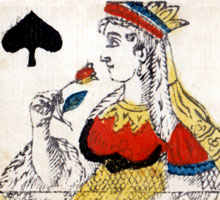
Above: early Jacob Holmblad deck, c.1820
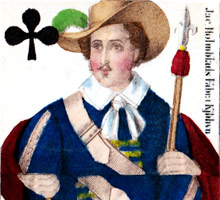
Above: Jacob Holmblad deck, c.1830
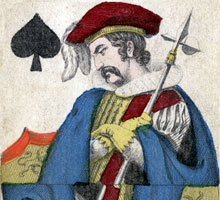
Above: playing cards by L.P. Holmblad c.1840
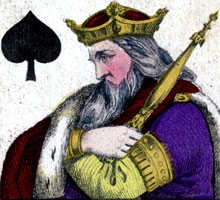
Above: House pattern, c.1850-80 See also: “Majestætiske fingeraftryk” • Holmblads standard pattern→

Above: unknown publisher, Denmark, c.1960. Advertising for cosmetics.
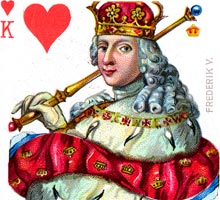
Above: Nationalkortet - Danish Kings & Queens, c.1930
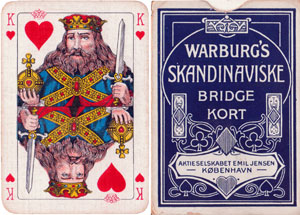
Above: Warburg’s Skandinaviske Bridge Kort, c.1935
REFERENCES
Hinrup, Hans J.: The Holmblad Playing Card Patterns, in "The Playing-Card" vol.33 no.4, IPCS London, Apr-June 2005.
Hinrup, Hans J.: interview/article in "Antik & Auktion" Journal, Denmark, January 2010.
Jensen, K. Frank: Royalty on Danish Playing Cards, The Playing-Card vol.32 no.1, IPCS, July-Aug 2003.
Jensen, K. Frank: French suited tarot packs in Denmark and the Jacob Holmblad Animal tarot, in "The Playing-Card" vol.36 no.3, IPCS London, Apr-June 2008.
Images courtesy Hans Jørgen Hinrup, K. Frank Jensen and Rex Pitts.

By Simon Wintle
Member since February 01, 1996
I am the founder of The World of Playing Cards (est. 1996), a website dedicated to the history, artistry and cultural significance of playing cards and tarot. Over the years I have researched various areas of the subject, acquired and traded collections and contributed as a committee member of the IPCS and graphics editor of The Playing-Card journal. Having lived in Chile, England, Wales, and now Spain, these experiences have shaped my work and passion for playing cards. Amongst my achievements is producing a limited-edition replica of a 17th-century English pack using woodblocks and stencils—a labour of love. Today, the World of Playing Cards is a global collaborative project, with my son Adam serving as the technical driving force behind its development. His innovative efforts have helped shape the site into the thriving hub it is today. You are warmly invited to become a contributor and share your enthusiasm.
Related Articles

Jim Lyngvild playing cards
Photographs of Danish royalty as imagined by fashion designer Jim Lyngvild.

Damn! Fools by Moon
Damn! Fools playing cards designed by Leo Scherfig, 2022.

Valhalla spillekort
Characters from the Valhalla comics, designed by Peter Madsen, as commemorated on a Danish stamp.

Old School Playing cards from Moon
Designed and published by Leo Scherfig

Dandy Rock’n Bubble
56 rock and pop stars of the 1980s, issued in Denmark with bubble gum.

Jeanne l’Hachette
Jeanne l’Hachette reprint of 19th century transformation deck, Denmark, 1976.

Velux International
Publicity pack for the Danish company, Velux, manufacturers of roof windows and skylights.

Russian Playing Card Monopoly
The Russian Playing Card Monopoly was established in March 1798 with all revenue going to support th...

Adolph Wulff Kort No.70
Playing cards for Denmark made by C.L. Wüst

Flying Tiger playing cards
An “eco-conscious” product with fun, modern designs from Denmark.

Dronning Margrethe II
Elegant, elongated cards designed by Queen Margrethe II of Denmark.

Nederlands Stedenkwartet
Nederlands Stedenkwartet with heraldic needlepoint patterns by Permin, c.1970.

Warburg’s Danske
Warburg’s Danske playing cards published by Aktieselskabet Emil Jensen, København, 1944.

Warburg’s Skandinaviske Bridge Kort
“Warburg’s Skandinaviske Bridge Kort” published by Aktieselskabet Emil Jensen, København, c.1935.

Standard Handa Pattern
Standard Danish playing cards made by Handa, Copenhagen.

Bjørn Wiinblad
Bjørn Wiinblad (1918-2006) was a Danish painter, designer and ceramics artist.
Most Popular
Our top articles from the past 28 days


